Thinking Globally
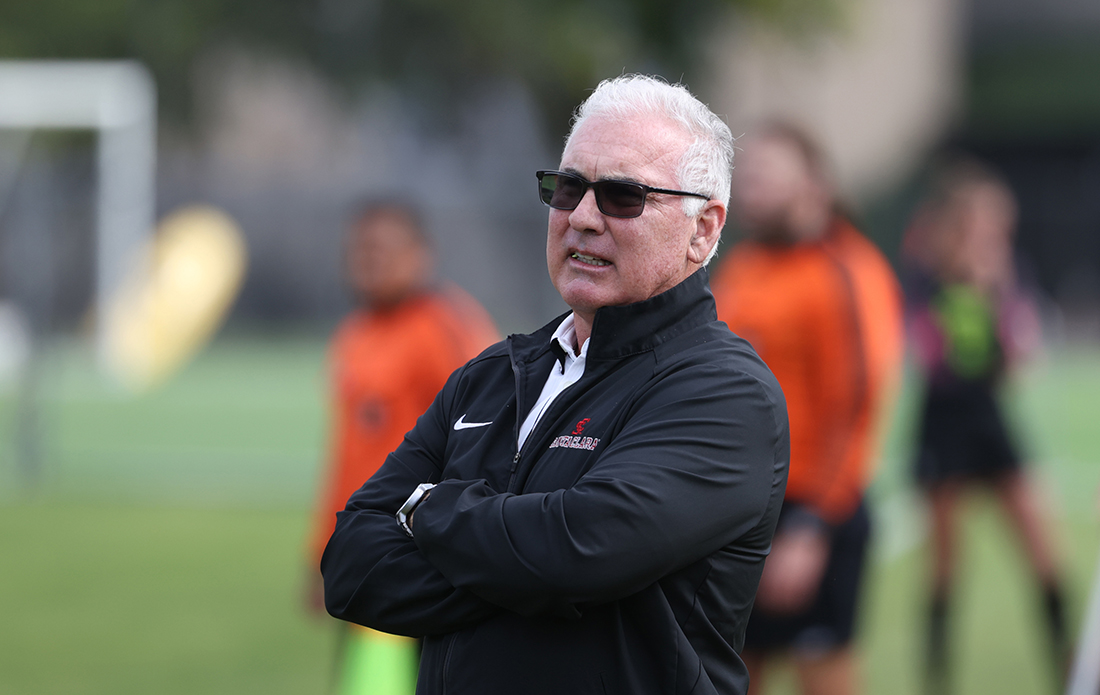
When someone asks Jerry Smith at the end of a season if he thinks a coaching job was a success, he says won’t know for about 10 or 15 years.
Coaching is about the long game, Smith says. Not tallying wins and losses but personal growth over the course of a lifetime.
“We don’t go a day without talking about life skills,” Smith says. “We can be good at soccer and achieve soccer goals, but these same skills—focus, work ethic, goal setting, discipline—are going to help you in relationships, in your community, and in your careers.”
Smith says there’s nothing more satisfying for a coach than getting a phone call or note from a former player who is living a happy and successful life.
“That’s the reward.”
This year’s World Cup in Australia and New Zealand is a testament to Smith’s work over the decades at Santa Clara. Watch the United States Women’s National Team play and you’ll see Broncos excelling everywhere. Not just Julie Ertz ’14 and Sofia Huerta ’15 on the pitch, but Leslie Osborne ’05, Danielle Slaton ’02, and Aly Wagner ’02 in the press box calling games.
The pro game isn’t much different. Wagner, Osborne, and Slaton recently joined Brandi Chastain ’91 to launch a new Bay Area NWSL team.
“They’re just giants and go-getters,” Smith says. “If you bundle that all together, there’s an overwhelming sense of pride.”
With the world’s eyes on Australia and New Zealand for this year’s World Cup, Santa Clara’s role in the global game has never been bigger. Recently, we sat down with Smith to get his thoughts on this year’s wide-open field, Santa Clara’s legacy, and the future of women’s soccer in the United States.
Since the first World Cup 32 years ago, Santa Clara has had at least one player representing the United States in each tournament. With so many personal and professional connections, do you watch it as a fan or a coach?
A little bit of both. You always try to learn. What are the trends? What are coaches doing? But certainly, when it comes to Santa Clara players, I’m watching to see how I can help them be successful. I’m careful not to offer any coaching. They have a coach. I focus on the mental side, trying to keep them positive. If it was three or four months ago, maybe I’d point out an area to improve but this is the World Cup. They don’t need my help to feel pressure.
Santa Clara is third all-time among U.S. colleges in sending players to the World Cup. What is it about your program that prepares players for international soccer?
It’s complex. For one, we play a brand of soccer that is conducive to the international game. The substitution rules in college are nothing like international soccer. Some bigger public schools will play 25 players and sub a lot, but we’ve never been super deep. We have to figure out how to win with 15 players. So we coach our players to be smart, conserve energy. That means the players who come through our program have been trained to play in a way that fits the international game.
We also have a reputation for developing players for the next level, which I think attracts a lot of the right types of players. Player development has always been more important to me than winning. It sounds funny to say because we’ve won a lot here—12 Final Fours and two championships—but you can’t control winning. I can control development. When we talk to recruits, I say, “Look, I’ll make you as good as you want to be. Whatever your potential is, I’ll get you there.” I think a lot of players want that challenge.
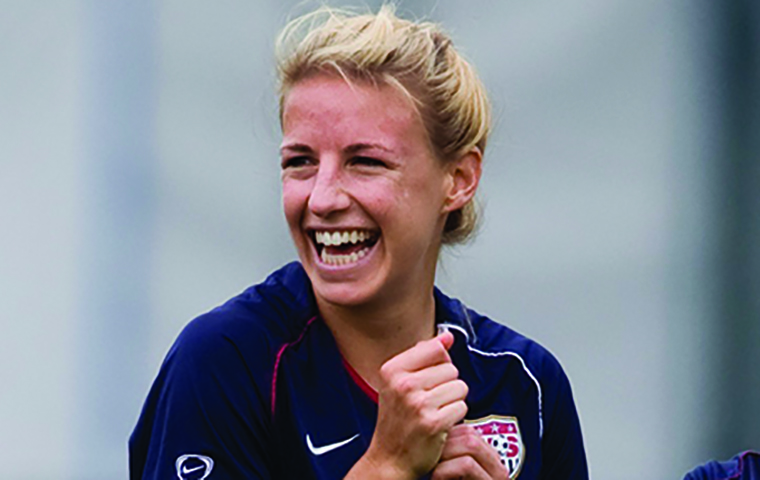
Aly Wagner is the match analyst for FOX Sports’ lead broadcast booth for the 2023 FIFA Women’s World Cup. As a player, she led Santa Clara to a national championship in 2001 and was a two-time Olympic gold medalist.
Telling a soccer player to conserve energy can be a tough sell for some. How do you get that message across?
I always tell our players, “We can become smarter or we can become fitter.” Most of the country is just fitness, but we watch film, make smart decisions, and learn how to conserve energy.
Everybody in college has GPS trackers on players when they play, so we track everything. But you have to educate the players on the data, because they’ll say, “Look at all these long sprints I’m making and all the ground I’m covering!” And that’s actually not what we want. I’ll say, “Well, that long sprint is because you were out of position. That ground you covered is because you misread several different things.” So we help them make smarter decisions.
Julie Ertz has had an unbelievable road back to the World Cup. Between a knee injury and giving birth to her son Madden in 2022, she hadn’t played competitive soccer since 2021. How hard is it to do what she’s done?
It’s unbelievably hard to do what she is doing. You know, injuries were part of it. Having Madden was part of it. But more importantly, Julie, she was ready to walk away from soccer. She’d had a great career, won two World Cups. Her husband Zach Ertz plays in Arizona for the Cardinals and her family is in Arizona, so everything was perfect for her to settle down and retire.
But six or seven months ago, USWNT coach Vlatko Andonovski reached out to her and said they were struggling and asked if she’d be willing to unretire. Julie said, “I’ll train for two months and come to camp. If I enjoy it, if you think I’m good enough, if my teammates think I’m good enough, then we’ll go from there.”
She’s worked her tail off for two months. I saw her the Friday before she left for camp. I happened to be in Arizona. I had lunch with Julie and she was as fit as she's ever been. She was like uber-fit. To go from having a child to being uber-fit in that short period of time—when you weren’t planning on doing it—is just amazing.
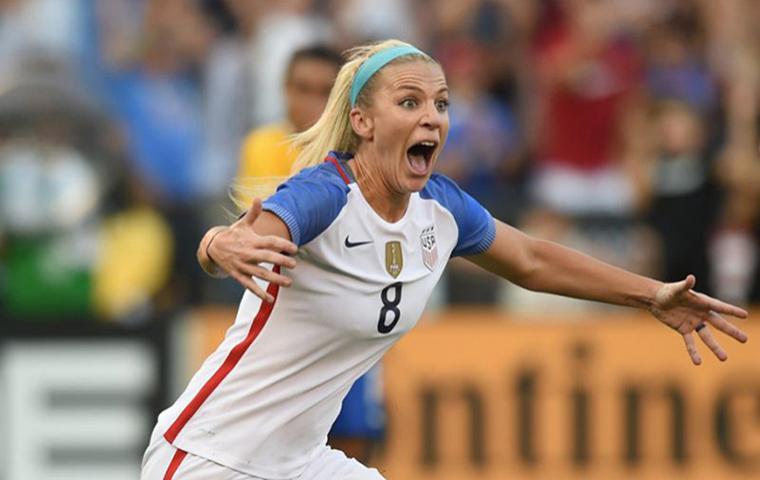
Julie Ertz was named U.S. Soccer Female Player of the Year in 2017 and 2019.
How was she able to pull that off when so many people couldn’t?
I think the mental part of it is the bigger challenge, but that’s where Julie beats everybody. She beats everybody on the mental side.
Her sophomore year, Julie wanted to play on the Under-20 World Cup team. She went to camp in January and I called the coach afterward to see what her chances were. They were deep in the midfield, so she was on the outside looking in. I asked the coach if he could bring her back to the next camp as a center back, where they weren’t as deep. He did, and of course Julie finished camp as their best center back.
So she went from not on the team in January, to being selected captain and winning the Silver Ball (second-most votes for MVP) and the U-20 World Cup in August. That’s just Julie—I’m gonna prove you wrong. I’m gonna be a difference maker. She’s still wired that way. She’s just uber-focused. And she and Zach are so good together. You talk about a power couple. They’re both cut from the same cloth. They push each other.
Sofia Huerta ’15 had an unconventional path to USWNT, starting with the Mexican national team before switching to the U.S. program. When did you first know she’d have a shot at an international career?
From the moment I saw her. What eliminates most people from playing at that level is athleticism. But with Sofia, she has elite speed, power, and agility. It was whether she was going to have the mental discipline to make it.
We had Sofia over at the house for dinner before their send-off game against Wales at PayPal Park in July. We reminisced about her growth. She came to Santa Clara as this immature kid and you look at what she’s doing now? It’s amazing, She’s probably grown the most out of anyone I’ve ever coached, and that’s good news and bad news because she had the most room to grow.
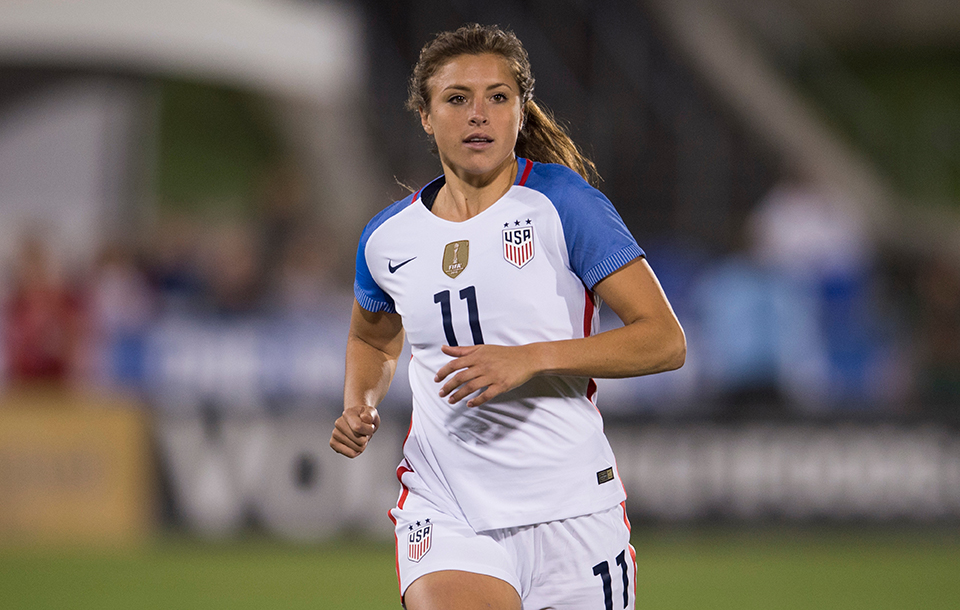
Sofia Huerta is the first woman to play for and against the U.S. and the Mexico national teams.
At Santa Clara, we do individual meetings with players. They’re optional, so some players meet once a month, others once a week. Sofia and I met three days a week for four years—Monday, Tuesday, and Thursday. I remember even in her first year as a pro, she’d reach out.
This World Cup is a happy ending for her. She has something special to offer. She’s the career leader in assists in NWSL, which is hard to do, period—but especially as a fullback. So if the U.S. needs a goal late, she can score, she can assist, and she delivers one of the best crossing balls on the team.
You have some experience representing the United States as the U-21 coach in 2001. What was that experience like?
I was very honored to represent the United States, but at the same time, you have a job to do. When I first heard from USWNT, I didn’t think it was the right fit. At that time, the staff came from the Anson Dorrance/North Carolina school of thought where it was all about endurance, fitness, and ground covered. That’s just not me.
But they said, no, that’s exactly why we want to bring you in. We need contrasting opinions. So I was able to bring in players like Carli Lloyd and Abby Wambach. The reason those two weren’t in the program was because they weren’t fit athletes. Abby was at the University of Florida. She didn’t fit the traditional, super-fit mold but she was a special goal scorer. There was zero difference between her right foot and left foot scoring, but she could also score with her head. When you coach the United States, you’re going to play against bunker defenses and the only way to score against a crowded box is to put it in the air. Looking at Abby, I thought, this kid is going to score goals, she’s going to score important goals, and she’ll score the goals that nobody else can score.
Now, Abby and Carli did need to be fitter, but they had special qualities. I thought if U.S. Soccer could meet me in the middle, we could have something special. When I submitted my roster for the Nordic Cup and Abby Wambach was on it, April Heinrichs, who was the national team coach, said if you think Abby can help you win the Nordic Cup, keep her on your team, but she’ll never play for the national team. Of course, Abby then went on to be the greatest goal-scorer of all time.
This year’s team is trying to bridge the gap between two generations. As a coach, how do you help that transition go smoothly?
That has to be a part of your culture. In sports, you have the rookie initiation where veterans are hard on younger players because that’s what they went through. At Santa Clara, one of the first things I did was flip it. Our captains are going to do the hardest work on the field. The next group is the seniors. The next group is the juniors. The first-year players actually have the least amount of work and responsibility because their whole life is already upside down. They’re away from home. They have a new level of academics and soccer. This is brutally hard, and our job is to make it as easy for them as possible.
Fortunately, the women’s national team has a great culture. The veterans do a great job integrating new players. That’s hard, because as a veteran, the younger players are trying to take your spot. But that’s the culture of USWNT and we’ve got Brandi Chastain, Michelle Akers, Julie Foudy, Carla Overbeck, Mia Hamm, and Kristine Lilly to thank for that. They welcomed new people to the team, and that culture lives on in players like Alex Morgan helping out Sophia Smith.
The United States has won two World Cups in a row but the world is starting to catch up as more countries invest in the women’s game. What do you think of the state of U.S. women’s soccer?
When I watch the U.S. team play now, it’s not good enough. It isn’t sustainable. In terms of player development, we’re not good enough to do what the French do, what the Spanish do, what the Germans do, what Brazil does, what Japan does. We’re not even close.
I honestly think we should de-emphasize winning. When I coached the U-21 team, the Nordic Cup was our big tournament and we won three times. But when you look at it, the Nordic Cup is five games in like eight days. We were going to win simply by being the deeper and fitter team. One year we played Sweden in the final without Abby. Sweden was coached by Pia Sundhage, who’s done a great job with Brazil. We won 7-0, but you could tell they were just worn down—and I could keep putting in fresh bodies. But if we were playing these countries with five days between games? We might be in trouble.
We had U-21 camp every three months and after every camp, the coach submitted a report. In all my reports for three years, it says we’re not going in the right direction. We need to be smarter. We need to be more skillful. When these other countries start investing in soccer, they’re going to blow by the United States.
So I’m prideful about being an American and representing the United States, but I honestly think we have a long way to go to catch up. They’re so far ahead of us. We could win this year. We’re tough. We’re athletic. We’re physical. We’re determined. But I wish we played better soccer.
Have you ever been interested in coaching the USWNT?
I was offered the head coaching job in 2008 but turned it down because I would’ve had to resign from Santa Clara. They called me at Boston Logan Airport and offered a one-year deal for the Olympics with the possibility of adding four more. I said I could take a one-year sabbatical from Santa Clara and they said no, you have to resign. I said, “Well, this is going to be a short phone call. I don't think you understand what you’re asking me to do. I love my job.”
As great as coaching the national team is at the Olympics and the World Cup, the rest of the time my job is way better. I love seeing kids grow. I love seeing them come in as immature freshmen and leave as seniors, ready to kick ass. I love that process. I love the day-to-day.
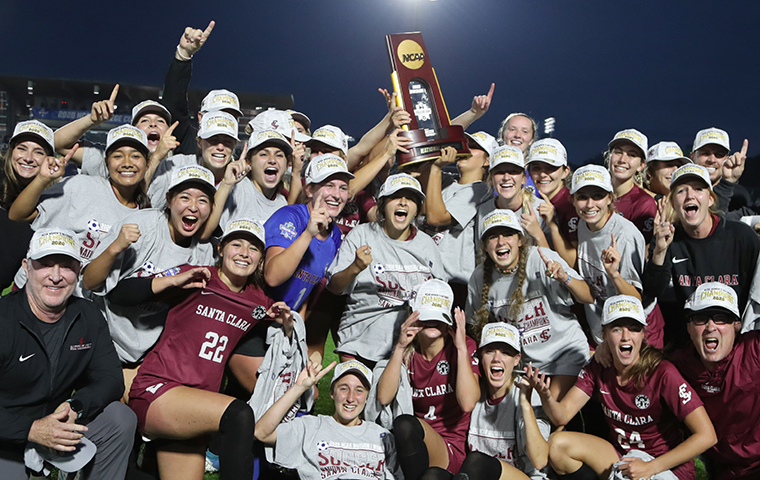
Santa Clara celebrates its 2020 national championship win over Florida State. The win marked Jerry Smith's second national title.
The global investment in women’s soccer is offering players more opportunities than ever to play at a high level, but it comes with some changes to managing a roster in the college game. How do you manage those changes?
I don’t stress about it. If a kid wants to transfer to a different university or go pro early, I don’t worry about any of that. I’m very much an optimist. Whatever happens, I believe there’s a positive side to it and I just focus on the positive.
We certainly have a lot more international students looking at us. Our 2024 class, we have a kid from New Zealand who is on their World Cup roster. We also have a player coming from Japan and one from Spain.
The other big change has been the transfer portal. Last year all eight teams in the Elite Eight had multiple starters from the transfer portal. It’s difficult for us because we don’t often have players leave our program, so there aren’t scholarships available to pursue transfers. So, we’re starting to hold money back during recruitment so we can go after transfers.
What does this year’s USWNT have to do to win the World Cup?
I’d like to see a complete overhaul, if I’m honest—rely less on athleticism, be less direct with our play, be more patient, play more balls on the ground, become a much better-passing team with better combination play. However, we are the No. 1 team in the world and the World Cup is not the time for an overhaul. So we have to double down on who we are at the moment—jam the ball forward and press. I would, however, like to see us use our depth much more. We have great depth with players like Megan Rapinoe, Alyssa Thompson, Sofia Huerta, and others. This will allow us to bring fresh, athletic legs off the bench in order to keep the pace of the match and energy level high.
Who do you think is next for Santa Clara and the World Cup?
Izzy D’Aquila ’23 of the Portland Thorns has a chance. Sally Menti ’24 is going to be a great pro. Sally is tracking for the national team. She was a starter for the U-20 team and got injured playing with them last year in Costa Rica. Between Izzy and Sally, both have a real good chance to play for the United States.